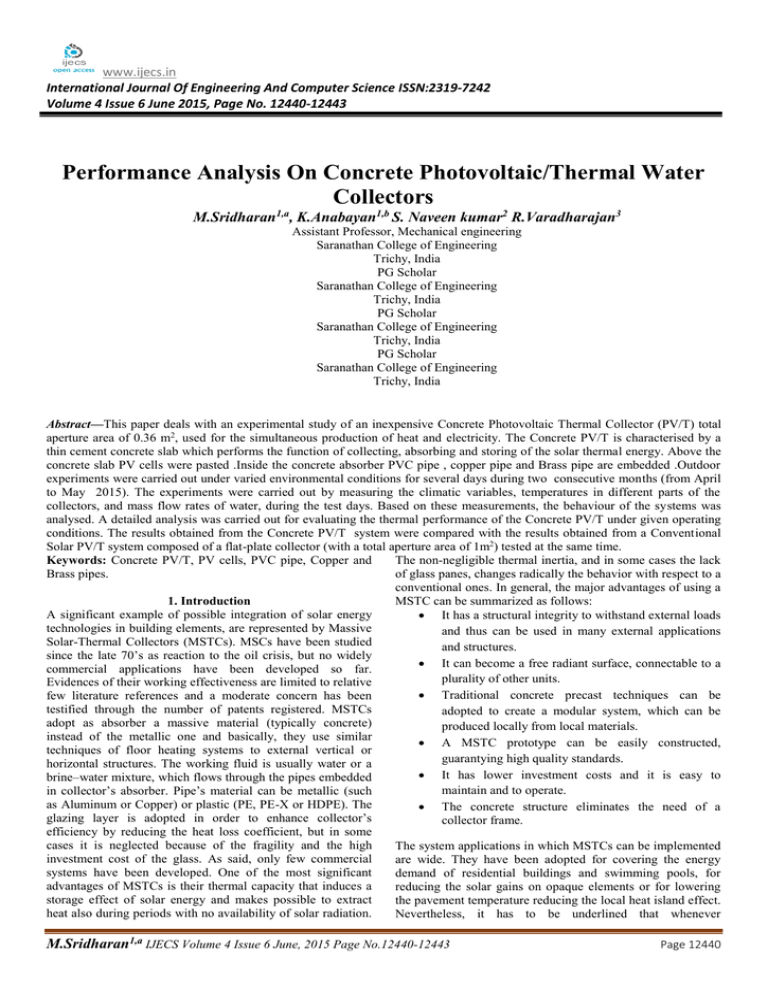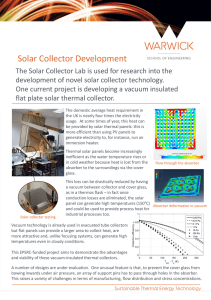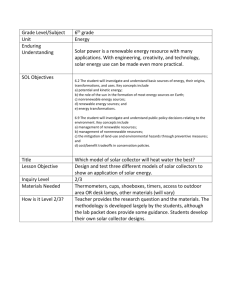www.ijecs.in International Journal Of Engineering And Computer Science ISSN:2319-7242
advertisement

www.ijecs.in International Journal Of Engineering And Computer Science ISSN:2319-7242 Volume 4 Issue 6 June 2015, Page No. 12440-12443 Performance Analysis On Concrete Photovoltaic/Thermal Water Collectors M.Sridharan1,a, K.Anabayan1,b S. Naveen kumar2 R.Varadharajan3 Assistant Professor, Mechanical engineering Saranathan College of Engineering Trichy, India PG Scholar Saranathan College of Engineering Trichy, India PG Scholar Saranathan College of Engineering Trichy, India PG Scholar Saranathan College of Engineering Trichy, India Abstract—This paper deals with an experimental study of an inexpensive Concrete Photovoltaic Thermal Collector (PV/T) total aperture area of 0.36 m2, used for the simultaneous production of heat and electricity. The Concrete PV/T is characterised by a thin cement concrete slab which performs the function of collecting, absorbing and storing of the solar thermal energy. Above the concrete slab PV cells were pasted .Inside the concrete absorber PVC pipe , copper pipe and Brass pipe are embedded .Outdoor experiments were carried out under varied environmental conditions for several days during two consecutive months (from April to May 2015). The experiments were carried out by measuring the climatic variables, temperatures in different parts of the collectors, and mass flow rates of water, during the test days. Based on these measurements, the behaviour of the systems was analysed. A detailed analysis was carried out for evaluating the thermal performance of the Concrete PV/T under given operating conditions. The results obtained from the Concrete PV/T system were compared with the results obtained from a Conventional Solar PV/T system composed of a flat-plate collector (with a total aperture area of 1m2) tested at the same time. Keywords: Concrete PV/T, PV cells, PVC pipe, Copper and The non-negligible thermal inertia, and in some cases the lack Brass pipes. of glass panes, changes radically the behavior with respect to a conventional ones. In general, the major advantages of using a MSTC can be summarized as follows: 1. Introduction A significant example of possible integration of solar energy It has a structural integrity to withstand external loads technologies in building elements, are represented by Massive and thus can be used in many external applications Solar-Thermal Collectors (MSTCs). MSCs have been studied and structures. since the late 70’s as reaction to the oil crisis, but no widely It can become a free radiant surface, connectable to a commercial applications have been developed so far. plurality of other units. Evidences of their working effectiveness are limited to relative Traditional concrete precast techniques can be few literature references and a moderate concern has been testified through the number of patents registered. MSTCs adopted to create a modular system, which can be adopt as absorber a massive material (typically concrete) produced locally from local materials. instead of the metallic one and basically, they use similar A MSTC prototype can be easily constructed, techniques of floor heating systems to external vertical or guarantying high quality standards. horizontal structures. The working fluid is usually water or a It has lower investment costs and it is easy to brine–water mixture, which flows through the pipes embedded maintain and to operate. in collector’s absorber. Pipe’s material can be metallic (such as Aluminum or Copper) or plastic (PE, PE-X or HDPE). The The concrete structure eliminates the need of a glazing layer is adopted in order to enhance collector’s collector frame. efficiency by reducing the heat loss coefficient, but in some cases it is neglected because of the fragility and the high The system applications in which MSTCs can be implemented investment cost of the glass. As said, only few commercial are wide. They have been adopted for covering the energy systems have been developed. One of the most significant demand of residential buildings and swimming pools, for advantages of MSTCs is their thermal capacity that induces a reducing the solar gains on opaque elements or for lowering storage effect of solar energy and makes possible to extract the pavement temperature reducing the local heat island effect. heat also during periods with no availability of solar radiation. Nevertheless, it has to be underlined that whenever M.Sridharan1,a IJECS Volume 4 Issue 6 June, 2015 Page No.12440-12443 Page 12440 approaching to the adoption of any solar technology, it is important to understand the local availability of the energy source and its compatibility with the requirements and peculiarities of the building loads. This statement is particular true for any MSTC system. 2. Experimental setup Three concrete solar PV/T collectors were fabricated with mixture of gravel, cement, sand and crush stones. The concrete mixture is in the ratio 2:2:1 of cement , sand and water .Concrete Slab collector dimension are 600 mm long×600mm wide and thickness 50mm.In collector1(slab1)PVC pipes are embedded and collector2(slab2) Copper pipes and in the Collector 3 (slab 3) Brass pipes are embedded. No additional thermal conducting materials, black painting and thermal conductive coating are used so to reduce the cost as much as possible and to check the performance of the Concrete PV/T in this simple fabrication. All the pipes were completely immersed inside the slab. Inlet and outlet pipes were provided for all the collector slabs. PV cells were pasted on the surface of the collector .the rating of the PV cells are 4 volts each .the inlet of the collector slab is now connected to the outlet of the water storage tank . The water storage tank used here is a rectangular one made of Stainless steel with dimensions of 300*300*300 mm3. The outlet of the collector is in this case an open system the outlet of the collector is open free and the temperature of the heated water from the collector is noted down. The collectors’ slabs are placed in the north south direction to have maximum exposure to sunlight throughout the testing period. The angle of inclination used here is 45 degree. As the collector starts to give out hot month of March–May, 2015. The readings were taken from morning 10 AM to5.00PM. 2.1 HEADER AND RISER TUBES The header and riser tubes are placed inside the Concrete PV/T collector. The riser tubes are vertically arranged between the two header tubes. The water flows inside the header and riser tubes. During a day time the collective tubes absorbs the heat from the sunlight and transfer to the water flows inside the tube. The thermometers are placed at the inlet and outlet of the concrete PV/T to measure the inlet and outlet temperature of the water. HEADER TUBE • Material : Copper, PVC, Brass • Length : 500 mm • Diameter: 19.05 mm • Distance between header tubes : 461.9 mm RISER TUBE • Material : Copper, PVC, Brass • Length : 461.9 mm • No. of tubes : 6 • Distance between each tubes : 84.76 mm • Diameter : 12.7 mm 2.2 ABSORBER / COLLECTOR The concrete used as the absorber and collector with the basic ratio of 2:2:1 of cement , sand and water content with gravels size ranging from 2.5mm to 3 mm.The dimension of the concrete slab is 600mm × 600mm×50mm. Flat surface area is 600mm×600mm. The thickness of the concrete slab is 50mm. 2.3 STORAGE TANK Storage tank is made up of stainless steel and the tank is insulated inside with the foam sheet. The size of the storage tank is 300*300*300 mm3. It has the inlet hole at the bottom. Then it is connected to the header tube inlet by copper tube. Initially the storage tank contains cooled water. 2.4 PV CELL The PV cell is pasted on the surface of the Concrete PV/T collector. Here the monocrystalline silicon cell is used. The number cells used in this project is 10. 2.5 ASSUMPTIONS Flow inside tube is viscous. One dimensional flow. Heat transfer between storage tank & surroundings are negligible. Water the temperature of the inlet normal water and the outlet hot water are noted down for every one hour once. Two thermometers are fixed in the outlet of the storage tank and at the outlet of the Collector. A ball valve is used to adjust the flow rate of water to the inlet of the collector and another ball valve is used to control the outlet flow rate. The Concrete PV/T collectors are rested on a sand bag used as a support as well as an insulating medium therefore by not allowing heat to dissipate on the unexposed side of the collector. The complete Concrete PV/T water collector experimental setup was installed at BHEL Trichy (10.7719° N, 78.7902° E) TamilNadu, India. The experiments were conducted during the 3. Working principle Concrete PV/T collectors are the combined arrangement solar flat plate collector and PV cell in a single system. It can simultaneously produce the thermal energy as well electrical energy. In principle, a PV/T module is similar to a solar thermal collector in term of heat Generation. The surface of the collector absorbs the heat from the sun rays and transfers it to the water passing through the pipes of the collector. Hot Water being lighter rises to the insulated storage tank and an equal amount of cold water replaces this hot water by the thermosyphon effect. This cycle repeats as long as the sun shines, resulting in all the water getting heated for distribution through pipes to the required usage points. The principle of the M.Sridharan1,a IJECS Volume 4 Issue 6 June, 2015 Page No.12440-12443 Page 12441 thermosyphon system is that cold water has a higher specific density than warm water, and so being heavier will sink down. Due to higher temperature differences at higher solar irradiances, warm water rises faster than it does at lower irradiances. Simultaneously PV cell is formed over the flat plate collector consists of “P” type silicon. This time a small amount of phosphorous is added to the mixture. The phosphorous mixture creates a negative characteristic and thus is referred to as “N” type silicon. When light penetrates to the junction of the “N” and “P” type silicon layers it creates a flow of electrons throughout the crystal structure. This flow of electrons occurs because sunlight is composed of photons, or particles of solar energy. When sunlight strikes a PV cell, some photons are absorbed. When enough sunlight (energy) is absorbed by the material (called a semiconductor), electrons are dislodged from the materials’ atoms. A crystal structure of silicon contains empty areas which accept the electrons. As one electron moves to fill a hole, it created another hole. It is the flow of these electrons that produces electricity. 4. READINGS AND OBSERVATIONS TABLE 1: READINGS OF CONCRETE PVC PV/T WATER COLLECTOR AT A MASS FLOW RATE OF 1 Kg/min Time Solar intensity Outlet temperature IST (Hrs) I (w/m2 ) ˚C 10 720.6 39.5 11 861.4 42.2 12 935.5 46.4 13 919.9 53.5 14 818.3 50.3 15 763.7 47.1 16 603.5 41.2 17 561.6 37.1 TABLE 2: READINGS OF CONCRETE COPPER PV/T WATER COLLECTOR AT A MASS FLOW RATE OF 1 Kg/min Time Solar intensity Outlet temperature IST (Hrs) I (w/m2 ˚C 10 720.6 43.1 11 861.4 47.3 12 935.5 51.3 13 919.9 56.5 14 818.3 53.2 15 763.7 49.4 16 603.5 43.1 17 561.6 40.2 TABLE 3: READINGS OF CONCRETE BRASS PV/T WATER COLLECTOR AT A MASS FLOW RATE OF 1 Kg/min Time Solar intensity Outlet temperature IST (Hrs) I (w/m2 ˚C 10 720.6 41 11 861.4 43.5 12 935.5 47.8 13 919.9 54.1 14 818.3 50.8 15 763.7 47.7 16 603.5 42.1 17 561.6 38.3 TABLE 4: READINGS OF CONVENTIONAL PV/T WATER COLLECTOR AT A MASS FLOW RATE OF 1 Kg/min Time Solar intensity Outlet temperature IST (Hrs) I (w/m2 ˚C 10 720.6 46 11 861.4 49 12 935.5 55 13 919.9 60 14 818.3 56 15 763.7 51 16 603.5 46 17 561.6 43 GRAPH 1: COMPARISON OF OUTLET TEMPERATURE BY DIFFERENT PV/T SYSTEMS M.Sridharan1,a IJECS Volume 4 Issue 6 June, 2015 Page No.12440-12443 Page 12442 [11] [12] [13] 5. Conclusion Hence the analysis of different PV/T water collector has been carried out and compared with conventional PV/T water collectors. From the experiment it is clear that the performance of the conventional PV/T is comparable with Concrete Copper PV/T. The order of performance is conventional PV/T , Concrete Copper PV/T, Concrete Brass PV/T and Concrete PVC PV/T. Thus Concrete PV/T is suitable for residential purpose as it is a cheap system when compared to Conventional PV/T. [14] [15] [16] References [1] [2] [3] [4] [5] [6] [7] [8] [9] [10] Basant Agrawal, G.N. Tiwari 2010;”Life cycle cost assessment of building integrated photovoltaic thermal (BIPVT) systems” Energy and Buildings 42(2010)1472-1481 Bilgen and M.A. Richard,”Horizontal Concrete Slabs As Passive Solar Collectors” Solar Energy Vol. 72(2002), No. 5, pp. 405–413 Chow TT, He W, Ji J, Chan ALS. “Performance evaluation of photovoltaic– thermosyphon system for subtropical climate application”. Sol Energy 2007; 81(1):123– 30. Chow, T.T., Pei, G., Fong, K.F., Lin, Z., Chan, A.L.S., Ji, J., 2009. “Energy and exergy analysis of photovoltaic-thermal collector with and without glass cover”. Appl. Energy86, 310–316. Feng Shan, Lei Cao, Guiyin Fang.”Dynamic performances modeling of a photovoltaic– thermal collector with water heating in buildings” Energy and Buildings 66(2013) 485-494 Garg HP, Agarwal RK. “Experimental study on a hybrid photovoltaic thermal solar water heater and its performance predictions”. Energy Conversion and Management 1994;35(7):621-633 H.A. Zondag, “Flat-plate PV–thermal collectors and systems: a review”, Renewable and Sustainable Energy Reviews 12 (2008) 891–959 He W, Chow T-T, Ji J, Lu J, Pei G, Chan L-s. “Hybrid photovoltaic and thermal solar- collector designed for natural circulation of water”. Appl Energy 2006;83(3):199–210 Jin-HeeKim, Se-HyeonPark, Jun-GuKang, Jun-Tae Kim .”Experimental performance of heating system with building integrated PVT (BIPVT) collector “ Energy Procedia 48(2014) 1374-1384 Krauter S, Araújo RG, Schroer S, Hanitsch R, Salhi MJ Triebel C, et al. “Combined photovoltaic and solar thermal systems for facade, integration and [17] [18] [19] building insulation”. Sol Energy 1999;67(4–6):239– 48. Krishnavel.V,Karthick.A,KalidasaMurugavel.K “Experimental analysis of concrete absorber solar water heating systems Energy and Buildings 84 (2014)501-505 Kumar R, Rosen MA. “A critical review of photovoltaic –thermal solar collectors for air heating”. Appl Energy 2011 ;88(11): 3603-14 Naewngerndee, R., Hattha, E., Chumpolrat, K., Sangkapes, T,Phongsitong, J., Jaikla, S. “Finite element method for computational fluid dynamics to design photovoltaic thermal (PV/ T) system configuration”. Solar Energy Materials and Solar Cells 95,390-393 Nayak J. K., Sukhatme S. P., Limaye R. G . and Bopshetty S.V.( 1989)” Performance studies on solar concrete collectors” Solar Energy 42(1), 45–56. P.J. Axaopoulos, E.D. Fylladitakis, “Performance and economic evaluation of a hybrid photovoltaic/thermal solar system for residential applications”, Energy and Buildings 65 (2013) 488– 496. Rangsit Sarachitt, Chaicharn Chotetanorm, Charoenporn Lertsatitthanakorn, Montana Rungsiyopas. Thermal performance analysis and economic evaluation of roof-integrated solar concrete collector Energy and Buildings 43(2001)1403-1408 Saloux E, Teyssedou A, Sorin M. “Analysis of photovoltaic (PV) and photovoltaic/ thermal (PV/T) systems using the exergy method”. Energy Build 2013;67:275-285 Tiwari GN, Mishra RK, Solanki SC. “Photovoltaic modules and their applications a review on thermal modelling”. Appl Energy 2011;88(7): 2287–304. Zondag HA, Vries DW, Helden WGJ, Zolingen RJC, Steenhoven AA. “Thermal and electrical yield of a PV-thermal collector”.Solar Energy 2002; 72(2):113-128. M.Sridharan1,a IJECS Volume 4 Issue 6 June, 2015 Page No.12440-12443 Page 12443



